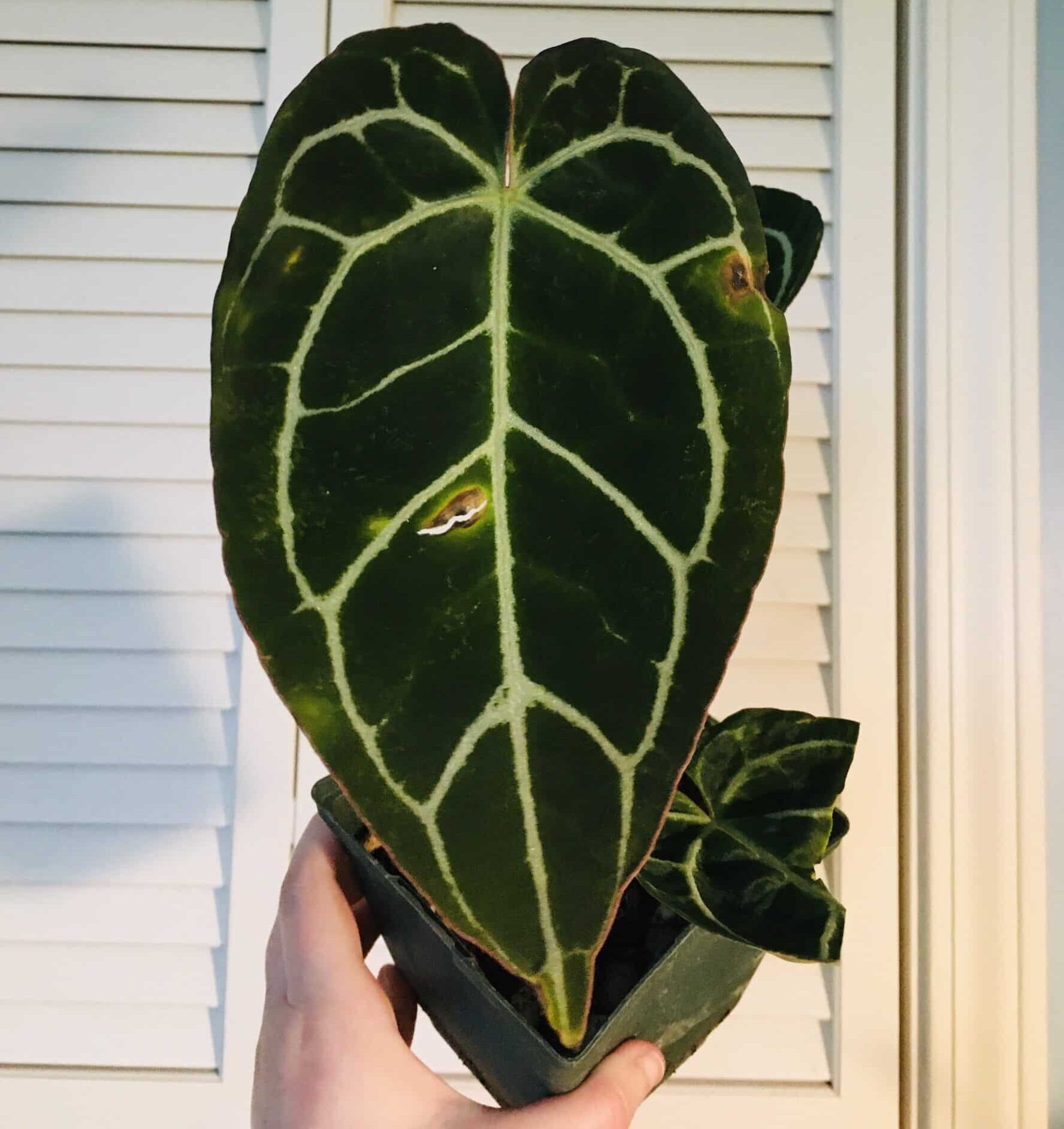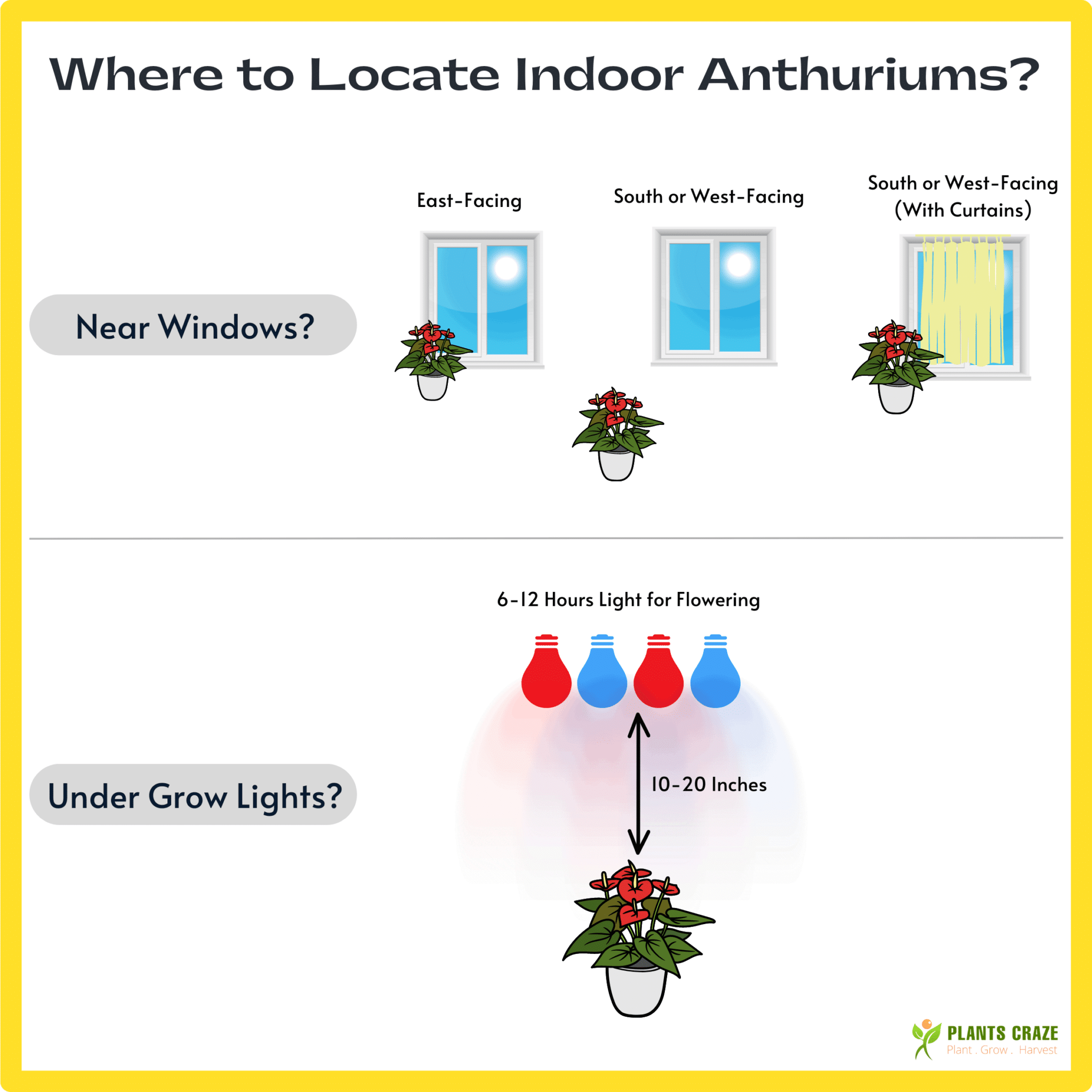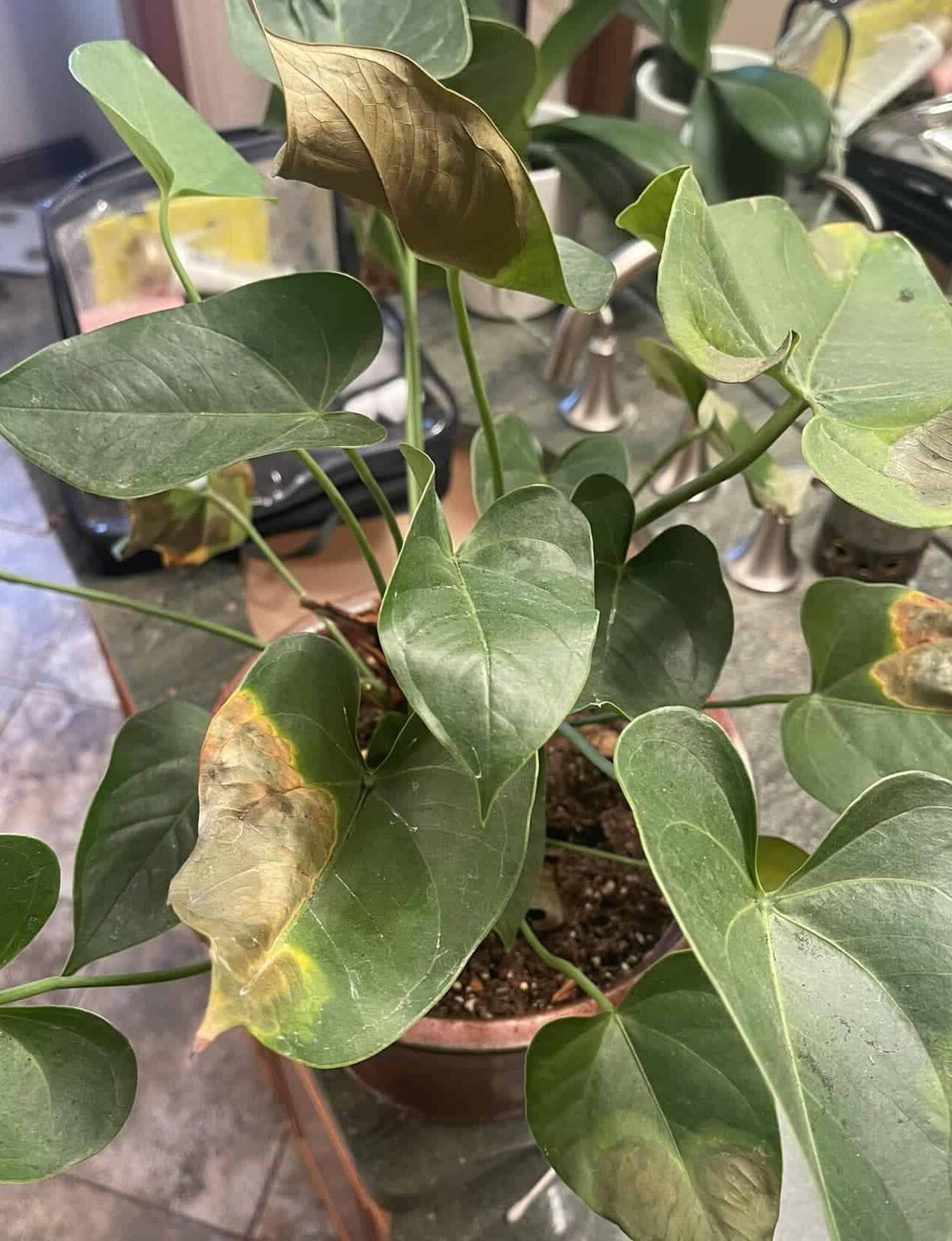Is your Anthurium growing off-color leaves and small blooms?
One of the main reasons for them to develop an uncanny appearance is inappropriate light.
To own Anthuriums, you must consider their placement based on their light demands.
So, keep reading to find the lighting requirements for your Anthurium.
Table of Contents Show
Overview of Anthurium
Anthurium is famous for its distinct aroid flower as well as ornamental leaves.
The plant gets its common name, “Laceleaf,” from the appearance of its leaves, usually sculpted with netted veins.
Besides, these broad and unique leaves of Anthuriums enable the plant to absorb even small flickers of light.
The plant has this ability, and many more, due to its tropical habit of growing under the canopy of the rainforest.
Let’s see some other interesting features of Anthuriums from the table below.
| Features | Description |
|---|---|
| Common Name | Anthurium, Laceleaf, Flamingo Flower, Tail Flower, and Painter's Palette |
| Botanical Name | Anthurium species |
| Family | Araceae |
| Native | Mexico, Central America, Northern South America, and The Caribbean. |
| Plant Type | Herbaceous Evergreen Perennial |
| Mature Height | 2-3 Feet (with more or less equal spread) |
| USDA Zones | 11-12 |
| Growing Seasons | Throughout Spring and Summer |
| Leaf | Arrow head or Heart-Shaped or Almost Oval Glossy, Smooth, Dark-Green to Green With Prominent Veins |
| Flowering Time | All Year Around (with bloom cycles of every 3 months) |
| Inflorescence (Flower Type) | Leafy, Variously Colored 'Spathe' and Erect, Cylindrical 'Spadix' |
| Toxicity | Toxic to both humans and pets |
However, the light requirements are similar for all Anthuriums, including A. crystallinum, A. clarinervium, and A. regale.
What are the Anthurium Light Requirements?
Anthuriums are indoor houseplants that must be kept in a shaded area in spring and summer, as exposure to harsh sunlight can kill them.
Anthurium prefers 8-10 hours of bright indirect sunlight. Moreover, placing them in an east-facing window is ideal for their optimum growth.

When bright direct light passes through the tree canopy or some translucent shade, it transforms into less intense light.
Hence, Anthuriums fond the kind of sunlight that is filtered or dappled.
In spring and summer, placing the plant near an east-facing window or 3-5 feet away from a south-facing window is an ideal lighting condition.
Additionally, you can grow them under artificial lights for 6-12 hours during the fall and winter, when the plant remains dormant.
This is because Anthuriums hate cold and prolonged exposure to chilly temperatures can slow the growth and, ultimately, the plant dies.
So, it’s appropriate to relocate the plant away from drafty north-facing windows in cold seasons.
How to Ensure Optimum Light for Anthurium?
Anthurium loves abundant indirect light but needs to be optimum, as excess or shortage of light can impact its growth.
You will know if your Anthurium is getting optimum light by looking at its leaves as it will start to show signs.
So, let’s look at some Anthurium light requirement tips and ways to pull them off.
1. Light Intensity
As the growth rate of Anthurium is related to the light it gets, it’s better to provide them with the necessary light to help them grow.
However, it does not mean you can place them in direct sunlight, as it can damage their foliage.

In the case of commercial Anthurium plantation, the light intensity of 1500-2000 FC (300-400 µmol) is ideal.
You can measure the light intensity using a light meter. You can hold it close to the leaves in the direction of the light source.
Anthuriums grow and flower best at a maximum light intensity of 1000-2000 FC.
In Hawaii, studies with Anthuriums revealed that lower light levels cause longer flower peduncles and larger spathes, while higher light levels increase flower production.
If your Anthurium is getting too intense light, you can use a sheer curtain to protect it from sunburn.
See below to find different locations with different light intensities.
| Light Intensity | Footcandles | Light Exposure |
|---|---|---|
| Low-Medium | 25 - 400 | North-Facing Window |
| Medium-Bright | 500 | East-Facing Window |
| Bright-High Light | 500 - 1000 | South-Facing Window |
| Direct Sunlight | Over 1000 | South or West-Facing Window |
2. Light Duration
Anthuriums naturally grow under a huge canopy of trees and receive seasonal 10-12 hours per day of filtered indirect sunlight.
To replicate this environment, you must put them close to a window sill or balcony where it receives the same hours of sunlight.
The plant can withstand 1-2 hours of direct sunlight in the morning, but any longer can damage the leaves.
Additionally, Anthuriums require artificial lights for 10-12 hours in a dim, north-facing room or during fall and winter indoors.

3. Light Quality
Sunlight has a wide variety of light intensities that affects Anthurium differently.
Like all plants, Anthurium also thrives in light with higher red and blue content and lower green and yellow content.
Numerous studies have revealed that plants benefit from a specific red and blue light ratio.
In this sense, LED artificial and automatic lights with red and blue spectrums can work well for Anthuriums during dormant days.
In addition, like many indoor plants, Anthurium also favors light bulbs with color temperatures ranging from 4000-6000 Kelvin.
4. Location for the Plant
Anthurium is a tropical plant that grows under the shade of tall trees in its natural habitat.
The east-facing windows remain protected from the intense light that arrives later in the day but receives a strong dose of gentle morning light.

On the other hand, if the space is large enough, you can position the plant 3-5 feet away from south-facing windows.
Signs your Anthurium Requires More or Less Light
Anthurium light requirements can confuse many people.
Since it is a shade-loving plant that requires adequate light for proper growth, many growers forget this and place it under the scorching daytime sun.
Extreme direct sunlight can dull the leaves to pale green and burn their tips and margins.
Likewise, less light can result in discoloration of leaves as the chlorophyll fails to make green pigmentation.
It can survive in low light, but the growth will not be as bushy as a plant getting the proper light.

Signs of Light Deprived Anthurium
Anthurium will show the following signs if it gets less light than it should.
- Lean plant with leggy stems and leaves.
- Soggy soil conditions as the plant cannot use the soil water.
- Stunted growth and fewer seasonal blooms.
- Yellow leaves due to a lack of sunlight.
- Leaves and flower drops.
Signs of Light Saturated Anthurium
Anthurium shows different signs when exposed to harsh sunlight for a long time.
- Leaves wilt and fade to a pale green or yellow.
- Brown sunburn spots or streaks at the tips and margins of the leaves.
- Curling of leaves to escape the sunlight.
- Quick drying of the potting soil.

Tips to Maintain Proper Light Condition for Anthurium
Here are some tips for fulfilling Anthurium light requirements.
- Move your plant near a south-facing window if the light is inadequate in fall and winter.
- Rinse the leaves with a damp cloth once a week.
- Rotate the plant to ensure it gets equal light around the foliage.
- Place them in the south or east-facing windows to see blooms in mid to late summer.
- Use sheer curtains if you place them in the south-facing windows.
FAQs About Anthurium Light Requirements
Can you Place Anthuriums Near a West-Facing Window?
A west-facing window receives direct afternoon sunlight, which can be torturing for Anthuriums.
So, keep the plant about 3-5 feet away or cling drapes to obstruct the pathway of direct sunlight to the leaves.
Is the Window Sill Suitable for Placing Anthuriums?
Window sills are great for potted Anthuriums, but it’s ideal to allow gentle morning sunlight if the window faces east.
Can Anthuriums Bloom Under Grow Lights?
Anthuriums need their daily requirement of bright indirect sunlight to keep their flowers and leaves using the sun’s energy.
Although grow lights offer a hospitable condition, Anthuriums don’t show much vigor to produce blooms and leaves under such artificial lights.
From Editorial Team
Maintain Distance Between Grow Lights and Anthuriums!
Grow lights are a great way to grant supplemental light for Anthuriums, but the plant should be at least 10-20 inches from the light setup.
Intense artificial light can also burn the leaves of young and mature Anthurium plants.


